Germany Satellite-based Earth Observation Market Size
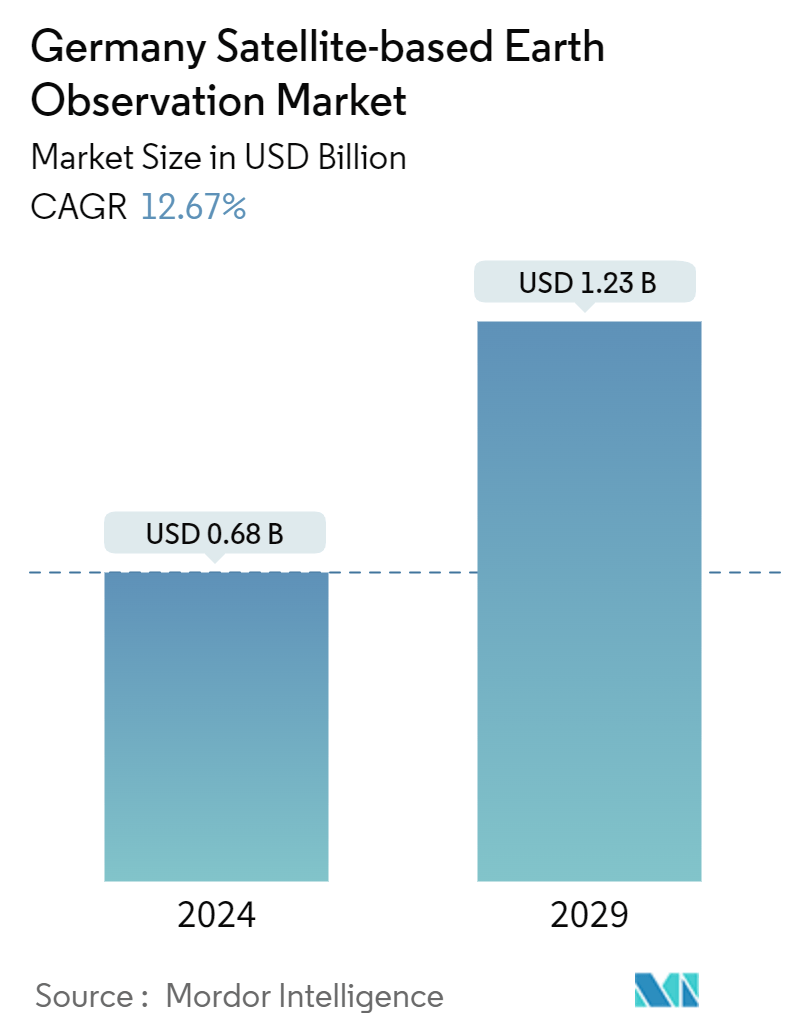
| Study Period | 2019 - 2029 |
| Base Year For Estimation | 2023 |
| Market Size (2024) | USD 0.68 Billion |
| Market Size (2029) | USD 1.23 Billion |
| CAGR (2024 - 2029) | 12.67 % |
| Market Concentration | Medium |
Major Players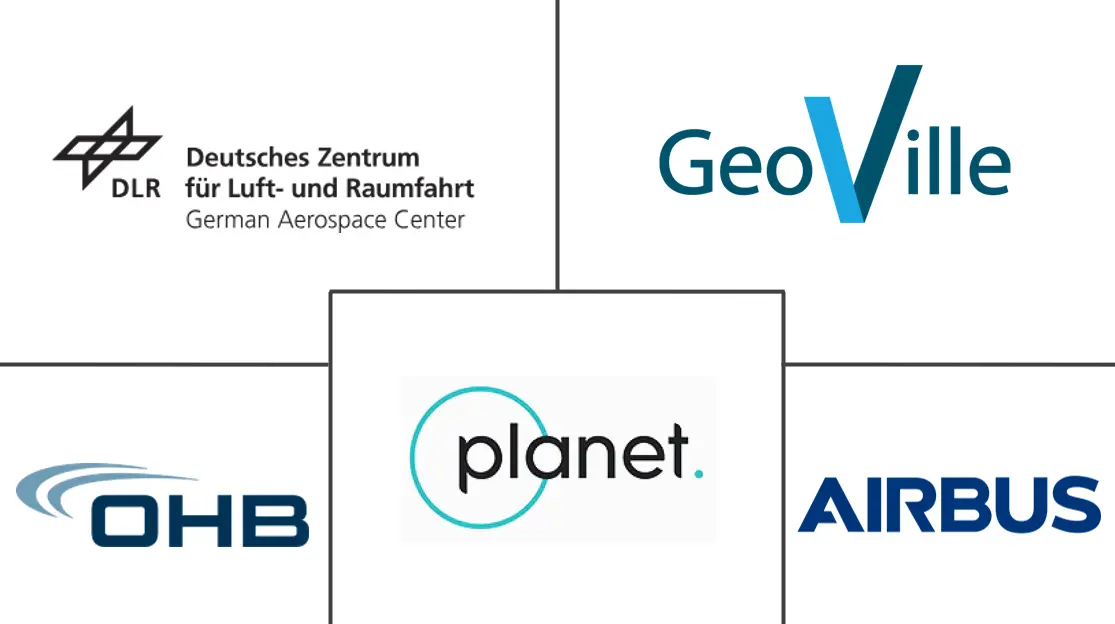
*Disclaimer: Major Players sorted in no particular order |
Germany Satellite-based Earth Observation Market Analysis
The Germany Satellite-based Earth Observation Market size is estimated at USD 0.68 billion in 2024, and is expected to reach USD 1.23 billion by 2029, growing at a CAGR of 12.67% during the forecast period (2024-2029).
Future advancements in satellite technology, including improved sensors, higher-resolution imagery, enhanced data processing capabilities, and the emergence of small satellite constellations, could drive the growth of the Earth Observation market. These technological advancements may increase data accuracy, better temporal and spatial resolution, and more cost-effective solutions.
- Germany has emerged as a key player in the global Earth Observation market, benefiting from its strong technological capabilities, research institutions, and government support. The country's focus on sustainability, environmental protection, and climate change mitigation has propelled the demand for satellite-based data and analysis. Germany has a well-established infrastructure for space research and satellite operations, with institutions like the German Aerospace Center (DLR) leading the way in developing and utilizing Earth Observation technologies.
- One of the primary drivers of the Germany Satellite-based Earth Observation market is the government's commitment to sustainable development and environmental monitoring. Initiatives such as the German Space Strategy, National Space Program, and the Copernicus program, in collaboration with the European Space Agency (ESA), emphasize the importance of Earth Observation data for addressing environmental challenges, climate change impacts, and disaster management.
- The market is witnessing technological advancements, including the development of high-resolution sensors, miniaturized satellites, and improved data processing capabilities. These advancements lead to more accurate and detailed Earth Observation data, enabling enhanced analysis and insights. Additionally, the integration of Earth Observation data with emerging technologies like artificial intelligence (AI), machine learning (ML), and big data analytics opens up new opportunities for advanced applications and decision-making processes.
- In addition, the increasing focus on environmental monitoring, climate change research, and sustainable development drives the demand for satellite-based Earth Observation data in Germany. Earth Observation satellites provide critical information for monitoring land use, deforestation, urban growth, pollution levels, and climate patterns. The need for accurate and up-to-date data to address environmental challenges fuels the growth of the market.
- While the Germany Satellite-based Earth Observation market holds immense potential, challenges exist, including data accessibility, cost-effectiveness, and the need for data standardization and interoperability. However, public-private partnerships, international collaborations, and commercialization efforts are addressing these challenges and creating opportunities for market growth.
Germany Satellite-based Earth Observation Market Trends
Technological Advancements to Drive the Market Growth
- Technological advancements play a crucial role in driving the growth of the Germany Satellite-based Earth Observation market. These advancements drive innovation, improve data quality and analysis capabilities, enhance satellite performance, and expand the range of applications.
- Technological advancements led to the development of more advanced and capable satellites for Earth Observation. These advancements include improvements in satellite sensors, data storage and transmission systems, power management, and propulsion technologies. Enhanced satellite capabilities enable higher-resolution imagery, more frequent data acquisition, and improved spatial and spectral resolution, resulting in higher-quality and more accurate Earth Observation data.
- Moreover, technological advancements have led to the development of advanced satellite sensors, such as high-resolution optical, hyperspectral, and synthetic aperture radar (SAR) sensors. These sensors provide more detailed and accurate Earth Observation data, enabling applications such as land cover mapping, crop monitoring, and environmental assessments with greater precision.
- Additionally, advancements in data processing and analysis techniques, including machine learning and artificial intelligence, have revolutionized the utilization of Earth Observation data. For example, satellite imagery combined with AI algorithms can automate the detection of changes in urban areas, identify deforestation patterns, or monitor coastal erosion. These advancements enable more efficient and accurate data analysis, expanding the range of applications in various industries.
- Such a significant rise in Patent applications reflects the innovative efforts and technological developments in significant fields, including satellite-based Earth Observation, thereby driving the market growth.
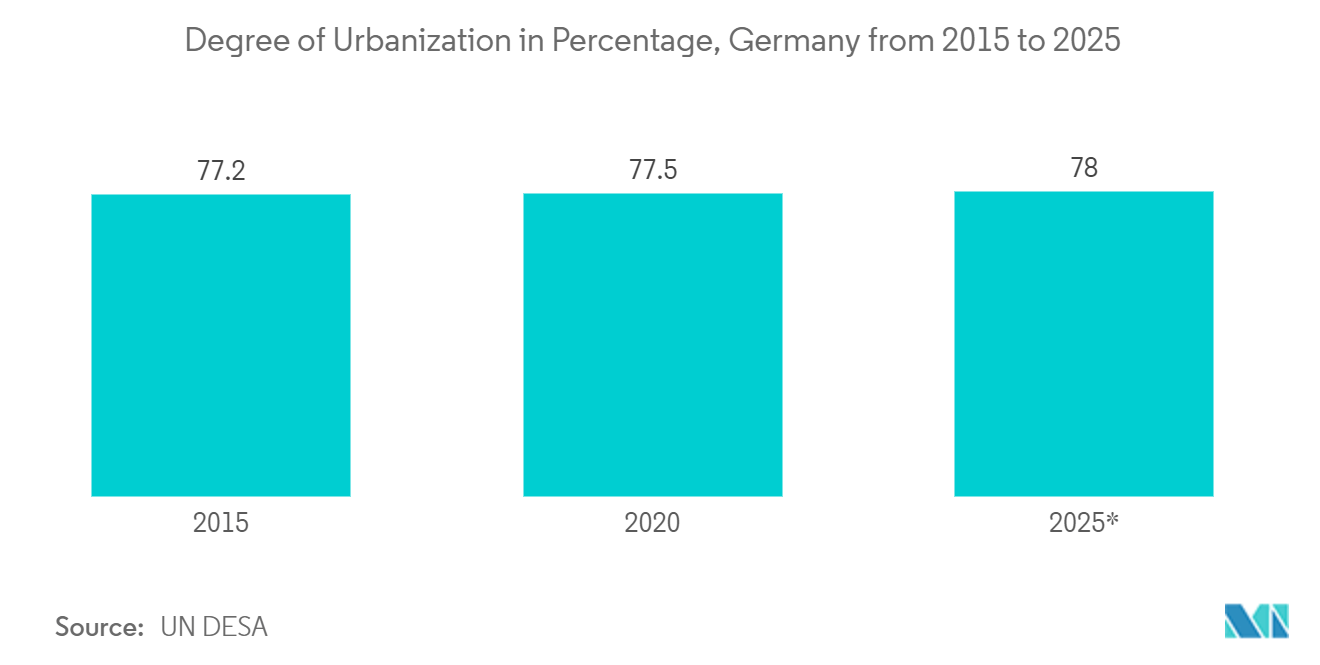
Urban Development and Cultural Heritage to Hold a Significant Market Share
- Germany is experiencing rapid urbanization, with an increasing population and expanding urban areas. For instance, according to World Bank statistics, 77.54 percent of all Germans resided in cities and urban regions in 2021. More than in other countries, roughly three-quarters of the German population currently resides in cities and urban areas.
- This growth necessitates effective urban planning, infrastructure development, and sustainable management of urban spaces. Satellite-based Earth Observation provides valuable data for monitoring urban expansion, land use, transportation networks, and infrastructure planning. It helps urban planners, architects, and policymakers make informed decisions and optimize urban development processes.
- Additionally, Satellite-based Earth Observation data support urban planning and management by providing insights into various aspects of urban environments. It helps assess urban sprawl, monitor urbanization trends, and analyze the impact of development projects on the surrounding areas. Earth Observation data assists in identifying suitable locations for infrastructure development, optimizing transportation networks, and managing urban ecosystems. These applications contribute to the efficient and sustainable growth of cities.
- Further, Germany is rich in cultural heritage, including historical sites, monuments, and landscapes. Satellite-based Earth Observation plays a vital role in cultural heritage conservation by providing non-invasive and wide-scale monitoring of these assets. It enables the identification of changes, degradation, and threats to cultural heritage sites. Earth Observation data assists in mapping archaeological sites, monitoring the condition of monuments, and supporting heritage preservation efforts.
- Overall, the combination of rapid urbanization, the importance of cultural heritage, and the tourism industry's significance makes urban development and cultural heritage key sectors within the Germany Satellite-based Earth Observation market. The use of satellite data in these domains contributes to sustainable urban development, heritage conservation, and the overall well-being of cities and their inhabitants.
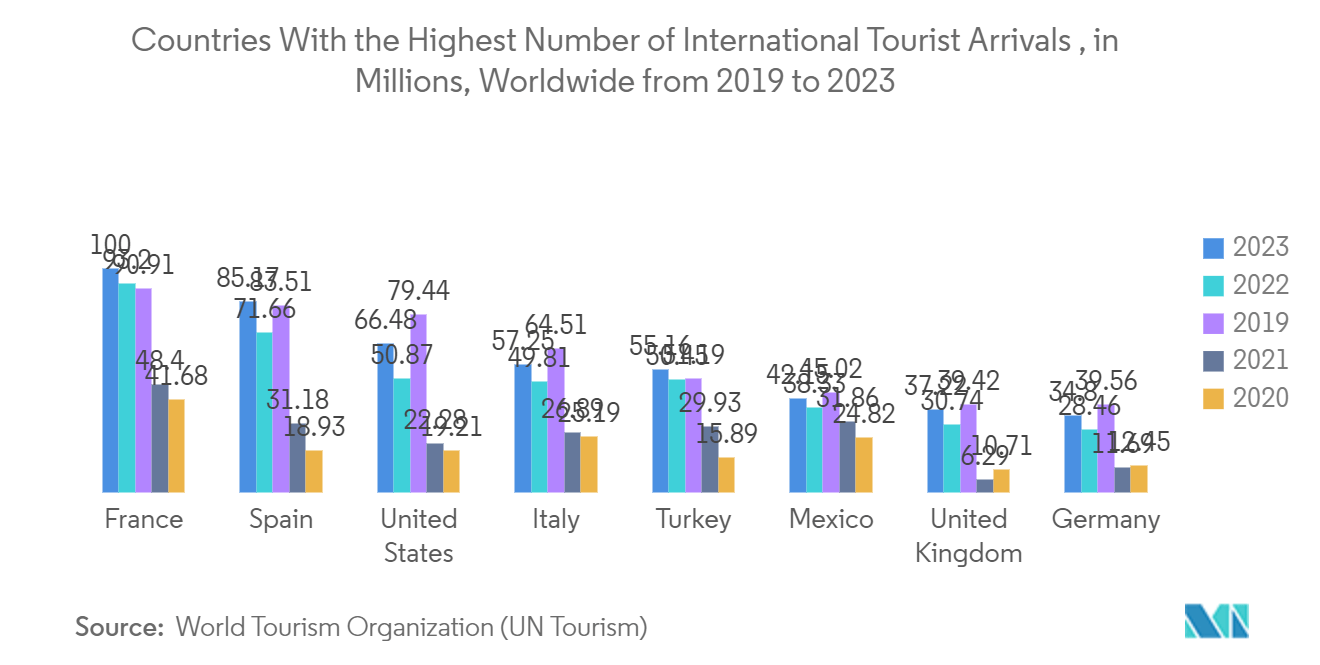
Germany Satellite-based Earth Observation Industry Overview
The Germany Satellite-based Earth Observation market is expected to be Semi consloidated in nature. The market serves various industries and sectors, each with unique requirements and applications. Market fragmentation arises from addressing diverse needs across sectors such as agriculture, environmental monitoring, urban planning, disaster management, and more. Different players may specialize in specific application areas, leading to a fragmented market landscape. Some prominent players operating in the market include Airbus SE, OHB SE, GeoVille Information Systems GmbH, Planet Labs PBC, and German Aerospace Center e. V. (DLR).
In July 2022, a new agreement between Planet Labs Germany GmbH and the German Federal Agency for Cartography and Geodesy (BKG) intended for Planet Labs to deliver the BKG with daily, high-resolution satellite data for crisis response, environmental and wildlife conservation, as well as forest and agricultural monitoring. The BKG will be able to enhance public and civic safety across the Federal Republic of Germany with access to satellite data. The partnership was introduced in November 2021, and after a successful trial phase, it is now being expanded.
In June 2022, the "SARah-1" Earth observation satellite, which was developed by Airbus and is presently being set up for launch in June 2022 and operation by Airbus in space, moved from Friedrichshafen, Germany, to Vandenberg, California, USA, under subcontract to OHB System AG.
Germany Satellite-based Earth Observation Market Leaders
-
Airbus SE
-
OHB SE
-
GeoVille Information Systems GmbH
-
Planet Labs PBC
-
German Aerospace Center e. V. (DLR)
*Disclaimer: Major Players sorted in no particular order
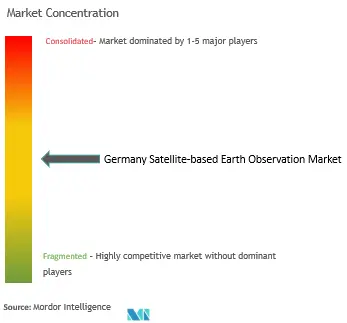
Germany Satellite-based Earth Observation Market News
- June 2024 - GeoVille willhas announced the upcoming release of DestinEstreamer, a new service on the DestinE Platform Data Cache. This innovative addition will significantly enhance the platform's capabilities by providing the highest data compression rates and the fastest data access. DestinEstreamer will be available through Jupyter Notebooks and a dedicated web application, allowing users to scan and access data wihtin the platform quickly and to generate imagery for public outreach.
- February 2024 –The European Space Agency (ESA) has chosen GeoVille as a partner for the Civil Security from Space Programme (CSS) in order to transform crisis communication for faster data exchange and prompt delivery of useful information during emergencies. GeoVille is teaming up with a diverse group of international experts from to combine knowledge in Earth Observation, Telecommunication, Big Data management, Artificial Intelligence for data management (compression technique, data fusion), Internet of Things IoT (measurement in the field) and new space with hyperspectral sensing.
Germany Satellite-based Earth Observation Market Report - Table of Contents
1. INTRODUCTION
1.1 Study Assumptions and Market Definition
1.2 Scope of the Study
2. RESEARCH METHODOLOGY
3. EXECUTIVE SUMMARY
4. MARKET INSIGHTS
4.1 Market Overview
4.2 Industry Attractiveness - Porter's Five Forces Analysis
4.2.1 Bargaining Power of Buyers
4.2.2 Bargaining Power of Suppliers
4.2.3 Threat of New Entrants
4.2.4 Threat of Substitutes
4.2.5 Intensity of Competitive Rivalry
4.3 Industry Value Chain Analysis
4.4 Assessment of the Impact of COVID-19 on the Market
5. MARKET DYNAMICS
5.1 Market Drivers
5.1.1 Technological Advancements
5.1.2 Increasing Demand for Earth Observation Data
5.1.3 Government Initiatives and Policies
5.2 Market Restraints
5.2.1 Data Accessibility and Cost
5.2.2 Regulatory and Legal Challenges
6. MARKET SEGMENTATION
6.1 By Type
6.1.1 Earth Observation Data
6.1.2 Value Added Services
6.2 By Satellite Orbit
6.2.1 Low Earth Orbit
6.2.2 Medium Earth Orbit
6.2.3 Geostationary Orbit
6.3 By End-use
6.3.1 Urban Development and Cultural Heritage
6.3.2 Agriculture
6.3.3 Climate Services
6.3.4 Energy and Raw Materials
6.3.5 Infrastructure
6.3.6 Others
7. COMPETITIVE LANDSCAPE
7.1 Company Profiles
7.1.1 Airbus SE
7.1.2 OHB SE
7.1.3 GeoVille Information Systems GmbH
7.1.4 Planet Labs PBC
7.1.5 German Aerospace Center e. V. (DLR)
7.1.6 GAF AG
7.1.7 SKYLAB aerial vegetation mapping GmbH
7.1.8 NV5 Geospatial Solutions, Inc.
7.1.9 EFTAS Remote Sensing Technology Transfer GmbH
7.1.10 Earth Observation Services Jena GmbH
7.1.11 Remote Sensing Solutions GmbH
- *List Not Exhaustive
7.2 *List Not Exhaustive
8. INVESTMENT ANALYSIS
9. MARKET OPPORTUNITIES AND FUTURE TRENDS
Germany Satellite-based Earth Observation Industry Segmentation
Satellite-based earth observation is done with the help of satellites orbiting around the planet to view and identify environmental changes, map making, etc. The satellite-based earth observation technology captures and stores information from satellites relating to the physical, biological, and chemical compositions of the Earth for monitoring, surveillance, and decision-making in various verticals, such as defense and intelligence, infrastructure and engineering, natural resource management, energy and power, and disaster management.
The Germany satellite-based earth observation market is segmented by type (earth observation data, value added services), satellite orbit (low earth orbit, medium earth orbit, geostationary orbit), and end-user (urban development and cultural heritage, agriculture, climate services, energy and raw materials, infrastructure). The market sizes and forecasts are provided in terms of value (USD) for all the above segments.
| By Type | |
| Earth Observation Data | |
| Value Added Services |
| By Satellite Orbit | |
| Low Earth Orbit | |
| Medium Earth Orbit | |
| Geostationary Orbit |
| By End-use | |
| Urban Development and Cultural Heritage | |
| Agriculture | |
| Climate Services | |
| Energy and Raw Materials | |
| Infrastructure | |
| Others |
Germany Satellite-based Earth Observation Market Research Faqs
How big is the Germany Satellite-based Earth Observation Market?
The Germany Satellite-based Earth Observation Market size is expected to reach USD 0.68 billion in 2024 and grow at a CAGR of 12.67% to reach USD 1.23 billion by 2029.
What is the current Germany Satellite-based Earth Observation Market size?
In 2024, the Germany Satellite-based Earth Observation Market size is expected to reach USD 0.68 billion.
Who are the key players in Germany Satellite-based Earth Observation Market?
Airbus SE, OHB SE, GeoVille Information Systems GmbH, Planet Labs PBC and German Aerospace Center e. V. (DLR) are the major companies operating in the Germany Satellite-based Earth Observation Market.
What years does this Germany Satellite-based Earth Observation Market cover, and what was the market size in 2023?
In 2023, the Germany Satellite-based Earth Observation Market size was estimated at USD 0.59 billion. The report covers the Germany Satellite-based Earth Observation Market historical market size for years: 2019, 2020, 2021, 2022 and 2023. The report also forecasts the Germany Satellite-based Earth Observation Market size for years: 2024, 2025, 2026, 2027, 2028 and 2029.
Germany Satellite-based Earth Observation Industry Report
Statistics for the 2024 Germany Satellite-based Earth Observation market share, size and revenue growth rate, created by Mordor Intelligence™ Industry Reports. Germany Satellite-based Earth Observation analysis includes a market forecast outlook to for 2024 to 2029 and historical overview. Get a sample of this industry analysis as a free report PDF download.



